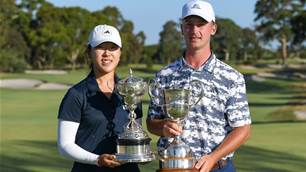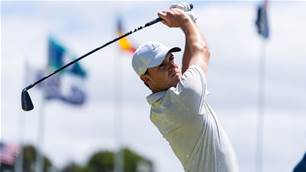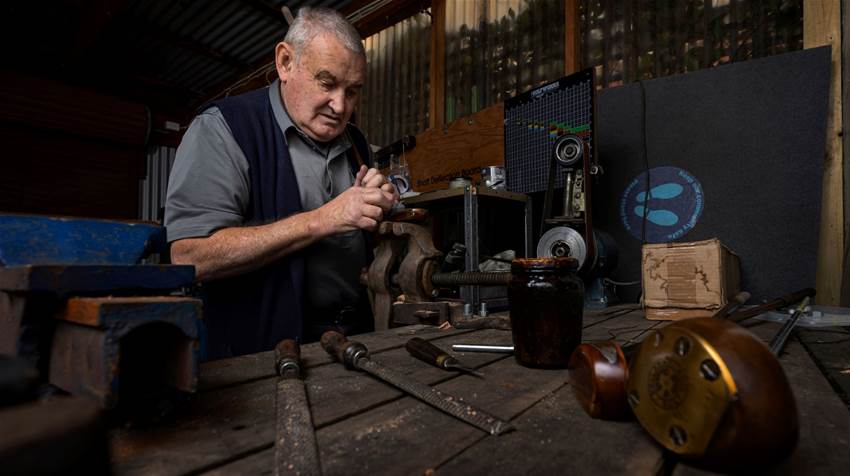It all started with a scrapbook. In truth, the seeds were there before that when Ross Baker first realised as a trainee golf professional that his skills lay more with making clubs than swinging them.
“I enjoyed using the tools and doing the hands-on stuff, the club repairs, and it just built from there.”
That interest in repairs, technology and club making – and its place in golf history, most particularly in Australia – took deeper root when he began cutting advertisements for clubs from newspapers and golf magazines and pasting them in a humble booklet.
Interest became passion and passion became obsession. “I’ve been living and breathing this for 50 years.”
A life’s love of technology has manifested itself in Australia’s largest collection of golf clubs – around 5,000 – and certainly the most comprehensive in telling the story of golf club manufacturing in this country, and beyond.
Baker estimates that around 80 percent of his collection is Australian clubs, the rest being items of particular importance: “Wherever there’s been a technical breakthrough or where interesting technology has been applied to some facet of club making, I’m immediately intrigued.”
This, then, means a volume and variety of clubs that would have collectors world over salivating. Consider these:
• A ‘rut iron’ forged by F&A Carrick of Musselburgh in Scotland, one of the earliest firms to forge irons. The rut iron, very small in the head, dates from 1870 and was named for its use for playing a ball from a wheel rut.
• A Robert L. Urquhart adjustable iron, which dates back to the late 1890s. This ingenious cleek could be adjusted to be anything from driving iron to wedge, convert to any angle to suit the lie and the shot to be played, and be used by both right- and left-handed players.
• A Winkworth Scott square shaft putter, circa 1913 and one of the first steel shaft putters made.
• A George F. Smith Anti-Shank iron, 1915, patented by Smith, stamped R Forgan & Sons St. Andrews and likely forged by James Anderson of Anstruther whose work began in the 1860s.
• A Lard Whistler, designed by Allan Lard in 1915, with a bored-out steel shaft resulting in a whistling sound when swung, a truly remarkable club.
• A Slazenger Frank Eyre 2 iron with Eyre’s nickname, ‘Happy’, imprinted on the face. Eyre won the 1930 Australian Open, the first year the Stonehaven Cup was presented.
• A Giant Niblick with its dot-punched face and massive head, forged by Hendry and Bishop in the late 1920s.
• A Walter Hagen Concave Niblick, the first club to be stamped ‘sand wedge’, made in the late 1920s and outlawed by the USGA a couple of years later.

And that’s not all.
Aside from woods and irons, Baker’s love of putters – “I’ve got over 1500” – means a sizeable chunk of the collection is given over to them, with gems such as an Old Tom Morris long nose putter from about the 1880s and a Willie Park Jnr putter, long nose and splice neck, also from the transitional era. That period, roughly 1860s to 1880s, was when golf clubs began to change shape in response to the move from the feathery ball to the gutta percha ball – but that’s another story.
Baker’s love of all things Karsten Solheim – “his technical mind was unbelievable” – means a huge range of PING putters, some 60 of them ‘common’ but around 15 older ‘collectibles’, including an original Redwood City A5 putter, an original Redwood City 3A putter and a rare original of the first PING putter, the 1A Redwood City.
Though not as visually attractive to some as centre block putters, this putter changed the design of putters with its heel-toe weighting and led to the development of the timeless Anser putter – but that’s another story too.
Then there’s the whimsical. The glass putter, the putters of different shapes and sizes, the putter with the head in the shape of a foot (there’s a lovely anecdote attached to this) and the one with the head of a Pepsi bottle. Yes, a Pepsi bottle.
But it is the Australian made clubs which have most drawn his attention and also his frustration over the years.

“All along my focus has been on collecting Australian clubs, while most collectors want clubs from St. Andrews and the U.S,” Baker said. “There’s an attached reverence for those because of golf’s early history but we completely ignore what was going on in Australia. So here I am, collecting what most people consider to be common stuff, but I don’t believe it’s common at all.”
Right: An incredible array of old clubs, balls and bags are part of the memorabilia exhibit. PHOTO: Daniel Pockett.
Indeed, it is not. It is unique, mapping out the course of a domestic manufacturing industry that for a period of time flourished, from the moment English club maker Richard Taylor arrived in 1891 right through the bulk of the 20th century before a combination of factors led to its decline around the mid-1980s.
For those who worship the romance of the origins of golf, there is enough of a Scottish-Australian, English-Australian and even U.S-Australian connection to gladden the heart. A few tidbits:
•The first club (wooden club) maker in Australia was Taylor, who migrated from Hoylake to take up the position of professional at the then Melbourne Golf Club, now Royal Melbourne, in 1891 aged just 20. As a club maker, Taylor did not forge iron heads – pros generally did not (to avoid setting fire to their shops!) – so iron heads were imported from England and Scotland.
•The first cleek (forged iron) makers in Australia were John Himmerman and Jock Kirk who settled from Scotland into Mordialloc, Victoria, in 1923. Himmerman had been the foreman of Tom Stewart, a cleek maker of renown in St. Andrews, whose cleeks were favoured by luminaries such as 1913 U.S Open winner Francis Ouimet and 1930 Grand Slam winner Bobby Jones. Himmerman and Kirk called their house ‘St. Andrews’ and their cleek mark was a cross with ‘St. Andrews’ on it.
•More recently (comparatively), the arrival of Alexander ‘Sandy’ Faichney from Scotland in 1948 to work for Slazenger, by then one of the giants of local golf club manufacturing. Perhaps the best testimonial of his work came from Lee Trevino in U.S Golf Digest magazine in June 2013:
“The set of irons I used at Merion, the best I ever had. When I went to Australia in 1969, David Graham told me about a great clubmaker named Sandy … These irons were unbelievable. I won the (1971) U.S Open, British Opens (1971, 1972) and my PGAs (1974, 1984) with them.
“One day, during a streak when I wasn’t playing well, I drilled holes in them to take some weight out – and ruined them. I still have them and when I look at them, I could cry. If I hadn’t tried to fix them, they might be in my bag to this day.”

Connections extend far and beyond these three examples; in fact, they branch into all parts of Australian golf history. To explore them is to fall into all sorts of delightful rabbit holes and many an hour can be spent doing so without realising the time passed.
But they do suggest the question: why do Australian golf collectors devalue Australian golf clubs? Is it part of ‘cultural cringe’, the term used first in 1950 to describe our national bent to see Australian work as inferior to overseas?
Or is it also, as Baker believes, that, “There isn’t an understanding of early club making and manufacture here because there isn’t a book on it. There are books on Forgan of St. Andrews, Gibson of Kinghorn, Nicoll of Leven and Stewart of St. Andrews, there are plenty of those, and so the collectors go for that. They don’t collect Australian stuff because they don’t know what it is, and they can’t identify it.”
Nor is there a co-ordinated national golf museum dedicated to Australian golf heritage as there are in other parts of the world.
“For 20-odd years I’ve been working to try and get a national museum. Every time it has looked like it might happen, it’s fallen through. I’m just really, really sad with how we’ve gone in relation to preserving and showing our history,” Baker said.
Baker himself has been able to piece together disparate fragments of club making history through dedicated research and from the clubs themselves by looking at the stampings imprinted by the club makers and then cross-referencing them over and over.
“That’s where I come into my fore, identifying early Australian clubs which other people have no knowledge of at all.”

It’s helped him solve mysteries, that’s for sure. Confirming that the cleek mark of Himmerman and Kirk, similar to Stewart’s, was not his but theirs, is one amongst several. He’s working on an unsolved one – the as yet unproven members of the group producing Airline clubs for a time between the early and late 1930s. He has some compelling thoughts on the subject but for now it remains a work in progress.
Pressed on the clubs he values most highly – “everything, everything!” – he finally nominates two from Taylor, a persimmon driver with a leather insert in the face, a repair job after damage caused by hitting the rock-hard gutty ball, and an iron which is the only one known to be in existence.
“It is so important in terms of Australian golf history, I can’t describe it, it’s just of paramount importance that that club is for all to see. Yet if you said the name Richard Taylor in or outside of Australia, few would know his name.”
Also in Baker’s possession are around a thousand golf books and some fascinating items: an extremely rare set of four leather boots used on horses hooves to protect the fairways whilst pulling horse-drawn mowers, a very early turf/sod cutter, an early 1900s instrument for measuring flight and distance of a tethered practice ball, and a late 1800s gutta percha ball mould-and-screw press.
He also has some interesting crockery and a set of old balls from wooden to feathery to gutta percha to Haskell, which was the forerunner of the modern ball. The feathery is a quality reproduction, an original being the one thing he would love to add to his collection.

So, what would he now like to see happen to it all? “Nothing would please me more than to see my collection housed where everyone could see it.”
For the moment at least, that means it will be the feature element of a unique retail venture, ATT Golf, a joint project between himself and well-known professional Henry Cussell.
Cussell is a story in himself. His road has taken him from being appointed head professional at Yarra Yarra Golf Club at just 20 years of age, through handling marketing and retail at Cape Schanck Golf Resort on the Mornington Peninsula, to Director of Golf at The National for 16 years before a segue out of the game for a time and now, thankfully, a return.
The nephew of Bill and the son of George, pro at East Malvern where the young Henry played his junior golf, he met Baker, then doing some repairs for Cussell Snr, in 1975 and the two have been friends since.
The juxtaposition of the two men’s skills and personalities is interesting. Where Baker is reserved unless talking about his passion, Cussell is extroverted. Where Baker’s skills lie in club making and encyclopaedic knowledge of club manufacturing and history, Cussell’s strengths are in his flair for merchandising and retail knowledge and his facility to mix with anybody and everybody equally. Between them they make for good yin-yang.
The two friends have been throwing the idea of this shop around for nearly eight years, becoming more serious three years ago.
Recently opened in Ormond, Melbourne, the store has something for everyone. There is retail merchandise, club selling and trading (not usual in retail golf shops), teaching and club fitting.
Then there’s Baker’s memorabilia exhibit (with items for sale) and a workshop at which customers and visitors will be able to watch him at work. With the rise in interest in hickory golf, a lot of Baker’s time is spent on restoring these.

“The people that play hickory golf are very enthusiastic and they want their clubs in the best playable condition.”
The traditional way of making hickory clubs uses multiple processes, each done by hand, and Baker is true to this. “The more I saw that these old skills were going, the more determined I was to keep them alive,” he said.
Some years ago, he identified that most old hickory clubs are too light and he has now perfected a process, quite complicated, to add weight to them. “I don’t know of anyone, certainly not in Australia and I haven’t really seen anywhere in the world, who is doing what I’m doing in relation to that.”
One of the ideas being tossed around, too, is doing events where Baker speaks of his work and educates on the history of club making.
Cussell knows well the challenge that lies ahead to make the store a success.
“Going into a standalone golf retail shop against the power of the franchises is tough but Ross’ collection is one of the most amazing things I’ve seen in golf. It deserves to be seen,” Cussell said.
“Our objective is to create something that is of genuine interest to golfers and celebrates the history of golf in Australia, not just as a game but as a manufacturing industry. It’s a celebration of all things worth celebrating. We both love golf and have a lot of respect for the traditions of the game. We feel we owe it to try and educate people about them. It’s going to be an interesting journey.”
For Baker: “The store is going to be a reflection of who we are. It’s small at the moment but who knows what it might grow into.”
And that scrapbook?
“I’ve actually still got it. It’s followed me everywhere.”
Related Articles

NSW duo Halls and Lee 2025 adidas Australian Amateur champions

O'Donovan and Lee take leads into final day at Australian Amateur













